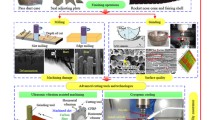Abstract
Rotary ultrasonic machining (RUM) has become an effective process for both hole making and surface grinding of carbon fiber reinforced plastic (CFRP) composites. Unlike other brittle materials such as ceramic, glass, silicon, etc., CFRP composites exhibit inhomogeneous and anisotropic properties, thereby resulting in different material removal mechanisms. However, the material removal mechanism in RUM of CFRP is still not clearly recognized in the literature. The lack of such knowledge would significantly limit the optimization and practical applications of RUM technique. In this work, single-grain diamond scratching tests without and with ultrasonic vibration are conducted to study the material removal mechanism in RUM of CFRP. Morphology of scratched groove, cross-sectional profiles, and scratching forces are analyzed. The results indicate that CFRP workpiece is extensively removed by the brittle removal mode, causing matrix damage, severe fiber pull-out, and macro-cracks in the conventional scratching test. Whereas, ultrasonic vibration-assisted scratching of CFRP leads to a larger ductile removal region before the successive brittle fractures and cracks. The fiber-matrix debonding and pullout phenomena are also remarkably reduced with only matrix buckling and fiber breakage occurring within the groove. The obtained results will enrich the understanding of the material removal mechanism in RUM of CFRP and contribute to the improvements of part quality during RUM of CFRP.
Similar content being viewed by others
References
Cong WL, Pei ZJ, Feng Q, Deines TW, Treadwell C (2012) Rotary ultrasonic machining of CFRP: a comparison with twist drilling. J Reinf Plast Compos 31(5):313–321
Ning FD, Cong WL, Pei ZJ, Treadwell C (2016) Rotary ultrasonic machining of CFRP: a comparison with grinding. Ultrasonics 66:125–132
Cong WL, Pei ZJ, Deines TW, Treadwell C (2011) Rotary ultrasonic machining of CFRP using cold air as coolant: feasible regions. J Reinf Plast Compos 30(10):899–906
Liu J, Zhang D, Qin L, Yan L (2012) Feasibility study of the rotary ultrasonic elliptical machining of carbon fiber reinforced plastics (CFRP). Int J Mach Tools Manuf 53(1):141–150
Cong WL, Pei ZJ, Sun X, Zhang CL (2014) Rotary ultrasonic machining of CFRP: a mechanistic predictive model for cutting force. Ultrasonics 54(2):663–675
Yuan S, Zhang C, Amin M, Fan H, Liu M (2015) Development of a cutting force prediction model based on brittle fracture for carbon fiber reinforced polymers for rotary ultrasonic drilling. Int J Adv Manuf Technol 81(5–8):1223–1231
Ning FD, Wang H, Cong WL, Fernando PKSC (2017) A mechanistic ultrasonic vibration amplitude model during rotary ultrasonic machining of CFRP composites. Ultrasonics 76:44–51
Ning FD, Wang H, Hu YB, Cong WL, Zhang M, Li YZ (2017) Rotary ultrasonic surface machining of CFRP composites: a comparison with conventional surface grinding. Procedia Manuf 10:557–567
Wang H, Ning FD, Hu YB, Fernando PKSC, Pei ZJ, Cong WL (2016) Surface grinding of carbon fiber–reinforced plastic composites using rotary ultrasonic machining: effects of tool variables. Adv Mech Eng 8(9):1–14
Liu S, Chen T, Wu C (2017) Rotary ultrasonic face grinding of carbon fiber reinforced plastic (CFRP): a study on cutting force model. Int J Adv Manuf Technol 89(1–4):847–856
Ning FD, Cong WL, Wang H, Hu YB, Hu ZL, Pei ZJ (2017) Surface grinding of CFRP composites with rotary ultrasonic machining: a mechanistic model on cutting force in the feed direction. Int J Adv Manuf Technol 92(1):1217–1229
Kitzig-Frank H, Tawakoli T, Azarhoushang B (2017) Material removal mechanism in ultrasonic-assisted grinding of Al2O3 by single-grain scratch test. Int J Adv Manuf Technol 91(9–12):2949–2962
Cao J, Wu Y, Lu D, Fujimoto M, Nomura M (2014) Material removal behavior in ultrasonic-assisted scratching of SiC ceramics with a single diamond tool. Int J Mach Tools Manuf 79:49–61
Jiao F, Zhao B (2011) Influence of ultrasonic assistance on material removal mechanism of hard and brittle materials based on single-point scratch. Key Eng Mater 487:413–418
Liang Z, Wang X, Wu Y, Xie L, Jiao L, Zhao W (2013) Experimental study on brittle–ductile transition in elliptical ultrasonic assisted grinding (EUAG) of monocrystal sapphire using single diamond abrasive grain. Int J Mach Tools Manuf 71:41–51
Zhang CL, Feng PF, Zhang JF (2013) Ultrasonic vibration-assisted scratch-induced characteristics of C-plane sapphire with a spherical indenter. Int J Mach Tools Manuf 64:38–48
Peng Y, Liang Z, Wu Y, Guo Y, Wang C (2012) Effect of vibration on surface and tool wear in ultrasonic vibration-assisted scratching of brittle materials. Int J Adv Manuf Technol 59(1–4):67–72
Zhang JF, Wang D, Feng PF, Wu Z, Zhang CL (2016) Material removal characteristics of KDP crystal in ultrasonic vibration-assisted scratch process. Mater Manuf Process 31(8):1037–1045
Zhou M, Zhao P (2016) Prediction of critical cutting depth for ductile-brittle transition in ultrasonic vibration assisted grinding of optical glasses. Int J Adv Manuf Technol 86(5–8):1775–1784
Anton RJ, Subhash G (2000) Dynamic vickers indentation of brittle materials. Wear 239(1):27–35
Jahromi AS, Bahr B (2010) An analytical method for predicting cutting forces in orthogonal machining of unidirectional composites. Compos Sci Technol 70(16):2290–2297
Acknowledgments
This work was supported by U.S. National Science Foundation through award CMMI-1538381.
Author information
Authors and Affiliations
Corresponding author
Additional information
Publisher’s note
Springer Nature remains neutral with regard to jurisdictional claims in published maps and institutional affiliations.
Rights and permissions
About this article
Cite this article
Ning, F., Wang, H. & Cong, W. Rotary ultrasonic machining of carbon fiber reinforced plastic composites: a study on fiber material removal mechanism through single-grain scratching. Int J Adv Manuf Technol 103, 1095–1104 (2019). https://doi.org/10.1007/s00170-019-03433-7
Received:
Accepted:
Published:
Issue Date:
DOI: https://doi.org/10.1007/s00170-019-03433-7




